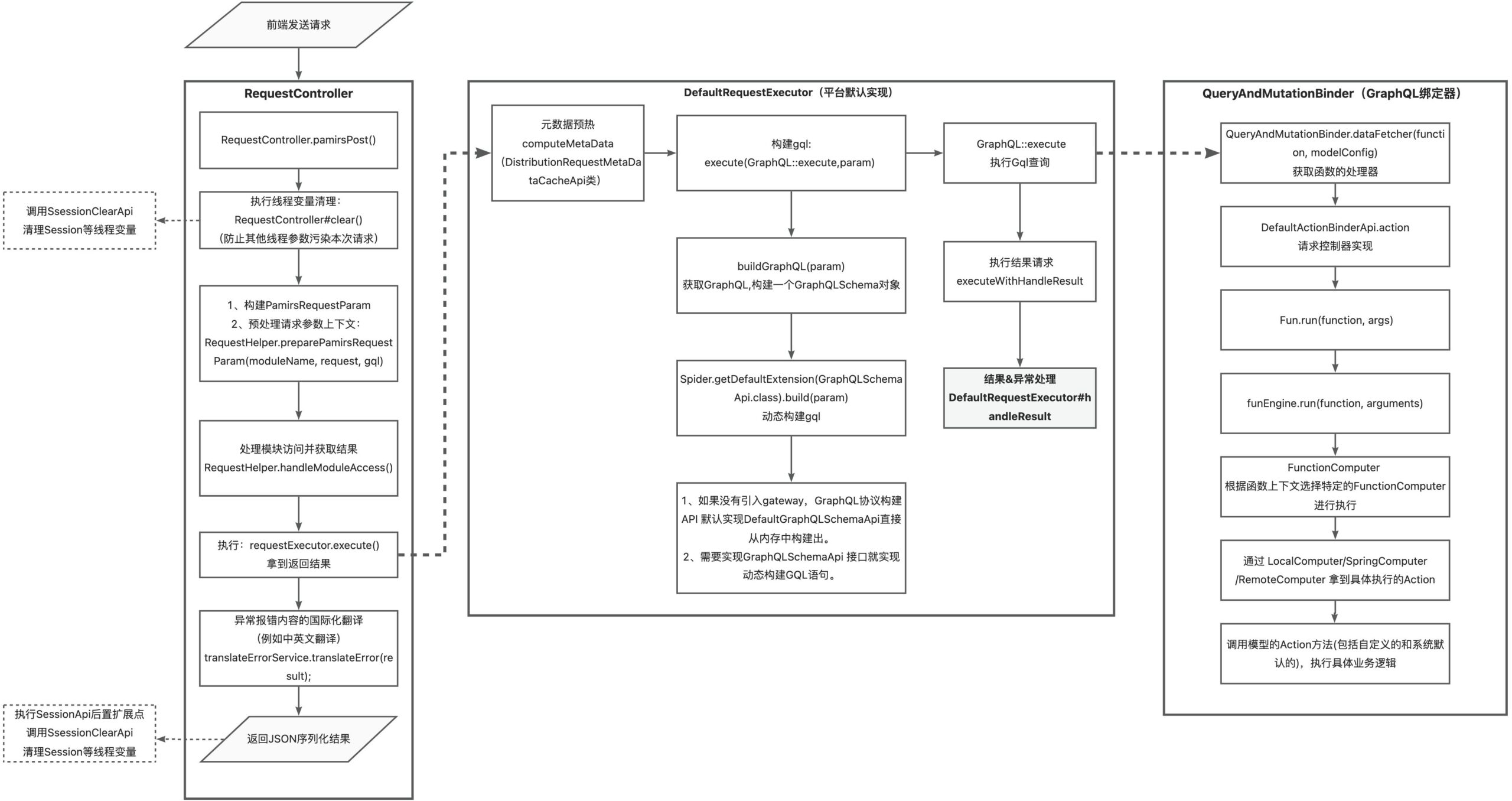开发辅助:使用GraphQL生成API文档
目标:在本节结束时,应当能够使用GraphQL生成API文档
一、后端接口实现逻辑解析

二、使用GraphQL生成API文档
GraphiQL 作为一款极为流行的交互式开发环境(IDE),专为浏览、编写以及测试 GraphQL 查询而设计。它不仅能够辅助您对 API 进行查询操作,还具备自动生成文档的能力。以下详细阐述使用 GraphiQL 的具体步骤:
仓库地址:https://github.com/anvilco/spectaql?tab=readme-ov-file#yaml-options
(一)使用GraphiQL 工具生成API文档。
1、GraphiQL 安装与配置
方式 : 本地或全局安装 GraphiQL
如果你的 GraphQL API 服务器没有内置 GraphiQL,你可以使用独立的 GraphiQL 框架或包。
- 全局安装 GraphiQL 如果你想在本地环境使用 GraphiQL,你可以通过
npm或yarn安装: 如果下载不成功可以使用淘宝镜像源
npm install -g graphiql- 通过 npm 或 Yarn 安装为开发依赖 你也可以将
GraphiQL作为开发依赖安装到项目中:
npm install graphiql- 生成您的文档!
npx spectaql config.yml运行此命令你需要一份config.yml文件。具体使用参考https://github.com/anvilco/spectaql?tab=readme-ov-file#yaml-options
2、使用JSON格式生成文档
生成或导出 schema 文件
- 自动生成 schema 如果你使用的是 Java 类和注解方式定义的 GraphQL API(使用
@GraphQLQuery等注解),GraphQL schema 通常在运行时生成。你可以使用 Spring Boot 启动后访问 GraphQL endpoint 来手动导出 schema。
下面是一个 introspection 查询的示例,它可以帮助你获取 schema:这个查询可根据文档需要动态调整。查询http://127.0.0.1:8091/pamirs/base,注意保证工程yml配置文件pamirs.framework.gateway.show-doc: true为开启状态。
注意:
pamirs/base是请求 base 模块下的接口,可以更换为业务模块返回业务模块的接口
query IntrospectionQuery {
__schema {
queryType { ...FullType }
mutationType { ...FullType }
subscriptionType { name }
types {
...FullType
}
directives {
name
description
locations
args {
...InputValue
}
}
}
}
fragment FullType on __Type {
kind
name
description
fields(includeDeprecated: true) {
name
description
args {
...InputValue
}
type {
...TypeRef
}
isDeprecated
deprecationReason
}
inputFields {
...InputValue
}
interfaces {
...TypeRef
}
enumValues(includeDeprecated: true) {
name
description
isDeprecated
deprecationReason
}
possibleTypes {
...TypeRef
}
}
fragment InputValue on __InputValue {
name
description
type { ...TypeRef }
defaultValue
}
fragment TypeRef on __Type {
kind
name
ofType {
kind
name
ofType {
kind
name
ofType {
kind
name
ofType {
kind
name
ofType {
kind
name
}
}
}
}
}
}你可以将这个查询放在 GraphiQL(开发工具)或者 Postman 等工具中,发送请求到 /base,这样可以获得完整的 schema。
- **访问 GraphQL Endpoint**:在应用运行时,GraphQL API 通常暴露在 `/base` 路径下。你可以通过 `introspection` 查询导出完整的 GraphQL schema。
将请求的响应保存为JSON文件,在config.yml中配置。配置参考:https://github.com/anvilco/spectaql/blob/main/config-example.yml
spectaql:
# Optional path to the target build directory.
# Set to null to not write the output to the filesystem, making it only available via the API (default: public)
#
# Default: public
targetDir: /Users/mmy/Desktop
themeDir: /Users/mmy/Desktop
introspection:
# File containing a GraphQL Schema Definition written in SDL.
# Can also pass an array of paths (or glob supported by @graphql-tools/load-files)
# like so:
# schemaFile:
# - path/to/schema/part1.gql
# - path/to/schema/part2.gql
# schemaFile: /Users/mmy/Desktop/schema2.graphql
# File containing Introspection Query response in JS module export, or JSON format
introspectionFile: /Users/mmy/Documents/response2.json
#
# URL of the GraphQL endpoint to hit if you want to generate the documentation based on live Introspection Query results
# NOTE: If not using introspection.url OR servers[], you need to provide x-url below
# url: 'http://127.0.0.1:8091/pamirs/graphql'
extensions:
# Utilize the 'graphql-scalars' library when generating examples for scalars it supports that
# do not have an example already set via some other method. Usually this is a good
# thing to have on, but it is possible to turn it off.
# Default: true
graphqlScalarExamples: true
servers:
- url: http://127.0.0.1:8091/pamirs/base运行命令npx spectaql config.yml就可以得到一份html的API文档啦!
注意:
这行命令生成文档的执行时间和文件大小息息相关。平台接口执行时间大概1-2小时,只要没报错请耐心等待!
(二)利用 schema.json 文件解析生成文档。
若第一种方式执行未能成功,可采用下述方案:借助第一步通过 GQL 请求所生成的 JSON 文件,手动解析该 JSON 文件以生成文档。在此,为您提供一个运用 Java 代码解析 JSON 文件的示例,您可依据实际需求对生成格式进行自主修改。
示例代码: gql-schema-api
规则说明:
- 数据提取范围:主要提取 “__schema” 下 “types” 中的内容。
- 接口区域数据判定与提取:当某类型的 “kind” 为 “OBJECT”,且其 “fields” 下的 “args” 存在值时,该部分数据属于接口区域数据。接口名称由 “name” 与 “fields” 中的 “name” 通过 “/” 连接构成。接口描述则截取 “fields” 中的 “description”。从 “args” 下 “type” 中,若 “kind” 为 “INPUT_OBJECT”,提取其 “name” 值作为请求参数名称;从 “fields” 的 “type” 中,若 “kind” 为 “OBJECT”,提取其 “name” 值作为返回参数名称。
- 接口区域数据记录格式:以表格形式展示接口地址、接口方式、请求参数名称以及返回参数名称。
- 请求参数区域数据判定与提取:当 “kind” 为 “INPUT_OBJECT” 时,此部分为请求参数区域。提取 “name” 值作为请求参数名称,针对 “inputFields”,以 “name” 作为字段名称,截取 “description” 作为显示名称。若 “inputFields” 的 “type” 下 “kind” 为 “SCALAR”,提取 “name” 作为字段类型。
- 请求参数区域数据记录格式:以表格形式展示请求参数名称,以及对应的(字段名,字段类型、显示名称、备注),其中备注为空。
- 返回参数区域数据判定与提取:当 “kind” 为 “OBJECT” 且 “fields” 下 “args” 无值时,此部分为返回参数区域。提取 “fields”,以 “name” 作为字段名称,截取 “description” 作为显示名称。若 “fields” 的 “type” 下 “kind” 为 “SCALAR”,提取 “name” 作为字段类型。
- 返回参数区域数据记录格式:以表格形式展示返回参数名称,以及对应的(字段名,字段类型、显示名称、备注),其中备注为空。
- 接口名称排除项:接口名称中不需要包含 “construct”、“queryByPk”、“queryListByEntity”、“queryOneByWrapper” 这些名称。
- 整体处理流程:对接口列表、请求参数数据区域以及返回参数数据区域分别进行上述处理。
- 请求参数关联展示:在处理后的接口列表中,依据请求参数名称,在请求参数数据区域查询对应的参数信息,并将(字段名,字段类型、显示名称、备注)以表格形式展示在对应接口信息之后。
- 返回参数关联展示:在处理后的接口列表中,依据返回参数名称,在返回参数数据区域查询对应的参数信息,并将(字段名,字段类型、显示名称、备注)以表格形式展示在对应接口信息下方的请求参数之后。